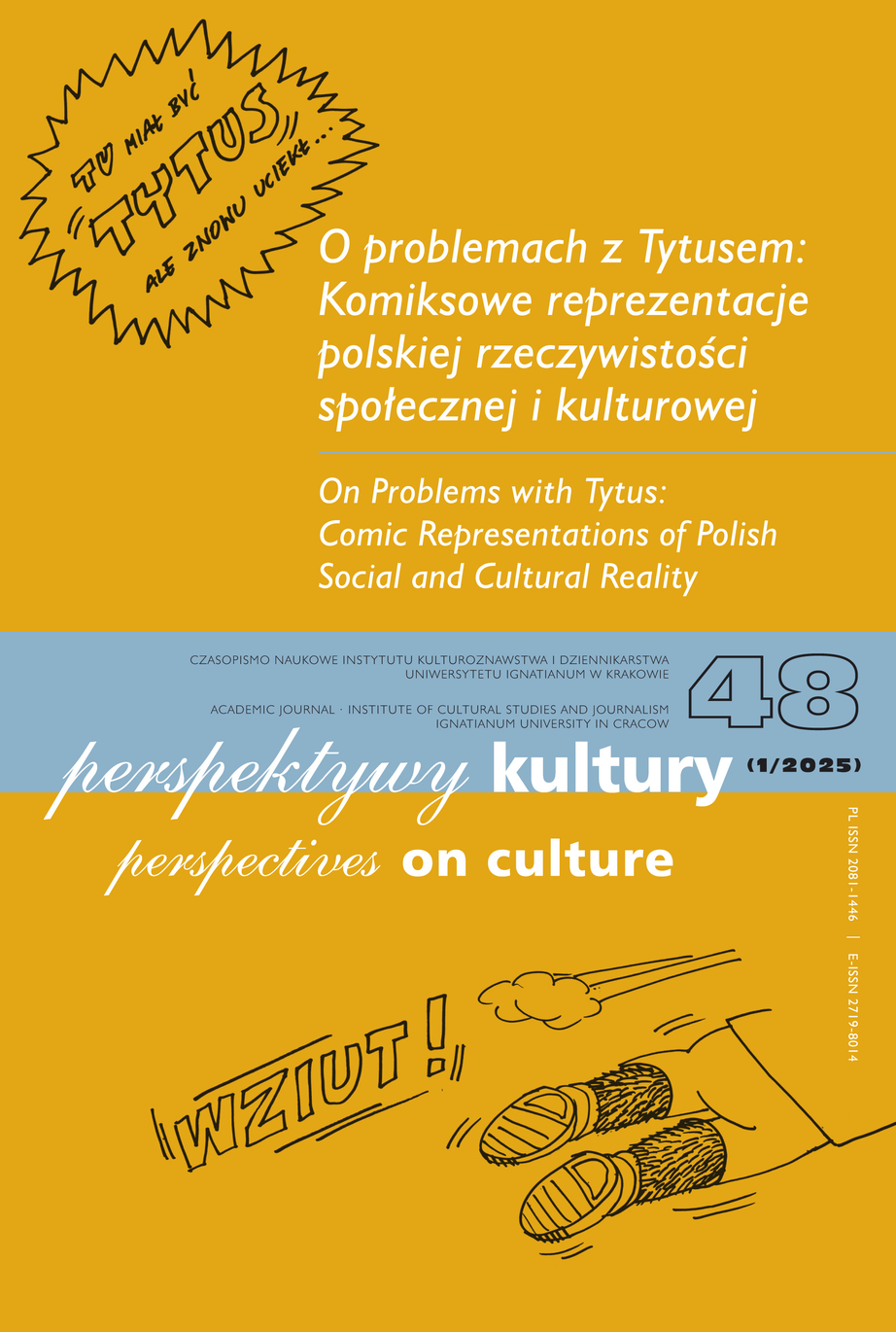Hearing Tytus
The Audiosphere of Henryk J. Chmielewski’s Comics Series Tytus, Romek and A’Tomek
Abstract
In this article, I discuss the sound sphere depicted by Henryk Jerzy Chmielewski in the Tytus, Romek and A’Tomek comic book series. While comics belong to the domain of sight, the sounds portrayed graphically cannot be physically heard. Reading a written or drawn text creates an image of the presented phenomena. Through the use of senses, people give a visually depicted sound a particular materiality, but primarily, it is a visual concept perceived by the human eye. Chmielewski’s comics, the audio dimension goes beyond the graphic representation of sound in drawn frames; it encompasses a whole range of references to extra-comic circumstances, as seen in some aspects of 20th-century culture, especially in the 17th episode of Tytus, Romek, and A’Tomek. It is assumed that the audio sphere in the comic books discussed in this paper appears in two forms: (1) textual determinants presented within the comic frames, and (2) metatextual determinants, such as the narrator’s comments or references to reality. This level of the audiosphere depends on the context: Tytus operates in a defined time and space, which includes sounds, music, and noises. I refer to these aspects of the sonic domain depicted in the comics, especially to the latter, since one of the albums is devoted to music. While reading it, one realizes how important sounds and music are for people as a part of the environment.
References
Berger, J. (2008). Sposoby widzenia. Warszawa: Fundacja Aletheia.
Chmielewski, H. J. (1999). Urodziłem się w Barbakanie. Warszawa: Prószyński i Spółka.
Chmielewski, H. J. (2009). Tytus, Romek i A’Tomek. Superkolekcja 25 ksiąg przygód. Warszawa: Prószyński i Spółka.
Chmielewski, H. J. (2013). Tarabanie w Barbakanie. Warszawa: Prószyński i Spółka.
Chmielewski, H. J. (2016). Żywot człowieka zmałpionego. Warszawa: Prószyński i Spółka.
Drisko, J., T. Maschi (2015). Content Analysis. New York: Oxford University Press.
Halliday, S. (2013). Sonic modernity: representing sound in literature, culture and the arts.
Edinburgh: Edinburgh University Press.
Hatfield, Ch., B. Beaty (red.). (2020). Comics Studies: A Guidebook. New Brunswick,
Camden, Newark: Rutgers University Press.
Heer, J., K. Worcester (2008). A Comics Studies Reader. Jackson: University Press of Mississippi.
Jeziński, M. (2023). „Zastęp, baczność!” Władza i przywództwo w komiksach serii „Tytus,
Romek i A’Tomek” Henryka Jerzego Chmielewskiego. Avant: W poszukiwaniu tytusologii, doi.org/10.26913/avant.3202220
Krippendorff, K. H. (2003). Content Analysis: An Introduction to Its Methodology. Thousand Oaks, London, New Delhi: Sage Publications
McCloud, S. (1994). Understanding Comics: The Invisible Art. New York, London, Toronto: Harper Paperbacks.
McCloud, S. (2006). Making Comics: Storytelling Secrets of Comics, Manga and Graphic
Novels. New York, London, Toronto: Harper Paperbacks.
Mirzoeff N. (2018). Jak zobaczyć świat. Kraków, Warszawa: Wydawnictwo Karakter.
Neuendorf, K. A. (2002). The Content Analysis Guidebook. Thousand Oaks, London, New Delhi: Sage Publications.
Pole, C. (2004). Visual Research: Potential and Overview. W: Ch. Pole (red.), Seeing is
Believing? Approaches to Visual Research. Amsterdam, Boston, Heidelberg: Elsevier – JAI Press, 1-7.
Rose, G. (2010). Interpretacja materiałów wizualnych. Krytyczna metodologia badań nad
wizualnością. Warszawa: Wydawnictwo Naukowe PWN.
Snaith, A. (red.). (2020). Sound and Literature. Cambridge: Cambridge University Press.
Copyright (c) 2025 Perspectives on Culture

This work is licensed under a Creative Commons Attribution-NoDerivatives 4.0 International License.
Autor, zgłaszając swój artykuł, wyraża zgodę na korzystanie przez Wydawnictwo Uniwersystet Ignatianum z utworu na następujących polach eksploatacji:
- utrwalania utworu w formie papierowej, a także na nośniku cyfrowym lub magnetycznym;
- zwielokrotnienia utworu dowolną techniką, bez ograniczenia ilości wydań i liczby egzemplarzy;
- rozpowszechniania utworu i jego zwielokrotnionych egzemplarzy na jakimkolwiek nośniku, w tym wprowadzenia do obrotu, sprzedaży, użyczenia, najmu;
- wprowadzenia utworu do pamięci komputera;
- rozpowszechniania utworu w sieciach informatycznych, w tym w sieci Internet;
- publicznego wykonania, wystawienia, wyświetlenia, odtworzenia oraz nadawania i reemitowania, a także publicznego udostępniania utworu w taki sposób, aby każdy mógł mieć do niego dostęp w miejscu i czasie przez siebie wybranym.
Wydawca zobowiązuje się szanować osobiste prawa autorskie do utworu.





